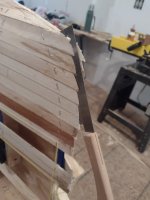I managed to get some time this weekend and put in a couple of hours on Saturday, stopping when I reached the midpoint.

Sunday, I cut out the centerline and started fitting strips into the football. It takes a bit for the glue to set sufficiently so I was also working on closing the sides of the tumblehome area and fixing my screw-up on the stern. The strips hadn't been aligning well (I suspect the taper wasn't consistent on the "stem" form) so I'd let the strips run out long on the stern. To fix it, I took my pull saw and cut through the strips & slightly into the form.

After 2 passes, the strips started aligning pretty well so I pulled the staples from the form, spread the strips (using wood chisels as prybars),

squirted glue in the opening and clamped tightly.

By cutting them together, I felt that the cuts would be uniform, if not parallel, and when spreading the strips, I found the cut surface was almost an inch wide. While I would think this joint will be a lot stronger than the bow (where I was more successful fitting the strips as I went), I do not think I'm brave enough to deliberately close the bow and stern in this manner on future builds.
With the stern mishap repaired, I started tapering pieces for the sides. I lacked the courage to just cut the whole side out of the boat to a uniform width below the starter strip so I treated those pieces as whiskey strips and tapered them individually. I also found that, on the left (port?) side, I had not gotten the gunwale strip all the way to the bottom of the forms on 2 adjacent forms.

I pulled the staples out of all 3 strips and was pleasantly surprised that they had enough flex to pull them down to the correct position.

Overall, I put in another 5 hours and I'll admit to being disappointed that I didn't have the football closed up. Fitting the strips was very time-consuming and clamping to keep them tight became tougher as the football closed. (Turns out I must not have gotten a picture but I wound up flipping the rubber handled clamps upside down & using the handles to push the strips)
I'll share 2 more screw-ups: When fitting the football strips, I found that the Cherry lined up well at the stern but not on the bow end. It turns out that I had gotten off to one side of the centerline while cutting.
![DSCN1380[1].JPG DSCN1380[1].JPG](https://www.canoetripping.net/data/attachments/26/26819-68ae4e456294a782f8f8615b2e6fce5c.jpg?hash=aK5ORWKUp4)
I debated trying to disguise it using some of the darker Aspen but, in the end, I decided to just fill it in. I figure it will hold fiberglass and I DO have the excuse that it was my first...
The other I found on Tuesday and it was where I had misaligned one of the "whiskey strips" on the sides. These strips often involved some creative clamping and I had not gotten enough pressure to hold it in place. I cut the glue line with a utility knife, re-glued and clamped it properly. (it seems to have worked and it turns out that wood is pretty forgiving)
![DSCN1365[1].JPG DSCN1365[1].JPG](https://www.canoetripping.net/data/attachments/26/26820-ff0237f14e8594828c13d563e93f4abe.jpg?hash=_wI38U6FlI)
I had work and other commitments on Monday so the 4th was my next opportunity and I got started early determined to get the hull closed up. The football went quickly and the whiskey strip there was done by 9:30 (a bit early for whiskey IMO).
![DSCN1370[1].JPG DSCN1370[1].JPG](https://www.canoetripping.net/data/attachments/26/26817-81e0f4b1596b5ec94e87e0bc03aa66e4.jpg?hash=geD0sVlrXs)
All that was left was the sides and I spent all day on those! I'll tell you, I'd better really like paddling this boat (or find an easier way to close those gaps) for this to be the one that gets rebuilt in Sumac.
Without the guts to just cut out the side, I wound up tapering strips (often to nothing) and sliding them in from the wide end.
![DSCN1368[1].JPG DSCN1368[1].JPG](https://www.canoetripping.net/data/attachments/26/26818-a5381c7a7dc668a458ddb98a626b017b.jpg?hash=pTgcen3GaK)
![DSCN1361[1].JPG DSCN1361[1].JPG](https://www.canoetripping.net/data/attachments/26/26821-cf587cd5792460f5e013dcda3cbf1c18.jpg?hash=z1h81XkkYP)
Most of the strips tapered to nothing and there just did not seem to be an easy way but by evening I had them all closed in.
![DSCN1378[1].JPG DSCN1378[1].JPG](https://www.canoetripping.net/data/attachments/26/26822-28bece7f675af1bff6891229b9b17ac1.jpg?hash=KL7Of2da8b)
I had finished gluing at the stern so I went to the bow and started pulling staples. As stated previously, I am not a woodworker. I am, however, a farrier so when I need something level, I do not reach for a scraper but, instead, I grab a rasp.
I'm tellin' ya; a good, sharp rasp makes short work of glue globs, high spots and uneven ends of strips at the bow (sorry, I somehow forgot to take a picture of the finished bow). In all, I "sanded" about 1/2 of the boat in about 20 minutes. I'll probably hit it quickly with 150 on an orbital and glass it. Sure, there will be scratches but it'll be pretty dinged up after a few paddles any way and this is, after all, a practice boat.
![DSCN1381[1].JPG DSCN1381[1].JPG](https://www.canoetripping.net/data/attachments/26/26823-aa3b700c6e845f63702c2408ed96e5e3.jpg?hash=qjtwDG6EX2)
Hoping to start (and finish) glassing this coming weekend but, unless I delay my Canada trip (I'm told the route is currently on fire), this boat will not be going North in 2 weeks.








![DSCN1380[1].JPG DSCN1380[1].JPG](https://www.canoetripping.net/data/attachments/26/26819-68ae4e456294a782f8f8615b2e6fce5c.jpg?hash=aK5ORWKUp4)
![DSCN1365[1].JPG DSCN1365[1].JPG](https://www.canoetripping.net/data/attachments/26/26820-ff0237f14e8594828c13d563e93f4abe.jpg?hash=_wI38U6FlI)
![DSCN1370[1].JPG DSCN1370[1].JPG](https://www.canoetripping.net/data/attachments/26/26817-81e0f4b1596b5ec94e87e0bc03aa66e4.jpg?hash=geD0sVlrXs)
![DSCN1368[1].JPG DSCN1368[1].JPG](https://www.canoetripping.net/data/attachments/26/26818-a5381c7a7dc668a458ddb98a626b017b.jpg?hash=pTgcen3GaK)
![DSCN1361[1].JPG DSCN1361[1].JPG](https://www.canoetripping.net/data/attachments/26/26821-cf587cd5792460f5e013dcda3cbf1c18.jpg?hash=z1h81XkkYP)
![DSCN1378[1].JPG DSCN1378[1].JPG](https://www.canoetripping.net/data/attachments/26/26822-28bece7f675af1bff6891229b9b17ac1.jpg?hash=KL7Of2da8b)
![DSCN1381[1].JPG DSCN1381[1].JPG](https://www.canoetripping.net/data/attachments/26/26823-aa3b700c6e845f63702c2408ed96e5e3.jpg?hash=qjtwDG6EX2)

![DSCN1352[1].JPG](/data/attachments/26/26814-27cb525215ac22f5bccbe086f13d9bfd.jpg?hash=J8tSUhWsIv)
![DSCN1354[1].JPG](/data/attachments/26/26815-4ec208c6f6fe99ac75ef49f76cc992bc.jpg?hash=TsIIxvb-ma)
![DSCN1355[1].JPG](/data/attachments/26/26816-23473b845856b57f204abf6c00b3a38c.jpg?hash=I0c7hFhWtX)




